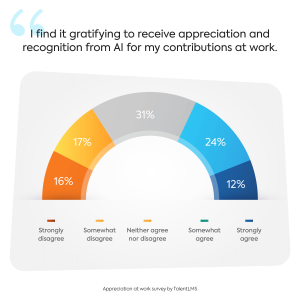- Is employee appreciation affected by work location? Nearly half say no
- Generational divide: Younger employees report feeling less valued than their older colleagues
- Pinning down the appreciation gap: Most employees feel recognized, but not sufficiently
- What form of appreciation do employees value the most?
- L&D and appreciation: The majority feel valued through workplace learning, yet 3 in 10 seek recognition for skill growth
- AI-powered praise: Over a third of employees embrace AI’s appreciation
- Building a culture of appreciation: Leadership appreciation, milestone celebrations, and personalization
- Wrapping up: Addressing under-the-radar challenges
In the latest TalentLMS research, we zoomed in on employee appreciation in U.S. companies. We examined how employees view appreciation practices. And their favorite ways of receiving recognition. Moreover, we explored AI’s potential for bridging the employee recognition gap. The research also dug into the generational differences surrounding appreciation. And investigated whether remote and on-site employees are equally recognized.
The results? At a top level, we see mixed feelings around workplace recognition. But what does this look like in detail?
Let’s see what else the data revealed.
Is employee appreciation affected by work location? Nearly half say no
Forty-five percent of employees feel acknowledged, whether they work remotely or on-site. Only a minority, 16%, feel they receive less recognition when working off-site.

This tells us two things.
Yes, most companies have good recognition practices across different working environments and arrangements. But they still need to work to bridge the gap between remote and on-site set-ups. Sixteen percent may seem like a small portion of the respondents. But distance is impacting the visibility of some employees’ efforts and contributions. And, to ensure parity for all, calls for strategies that target that minority.
Generational divide: Younger employees report feeling less valued than their older colleagues
Diving deeper into the data, a divide in views across age groups emerges.
Seventy percent of employees over 54 years old report feeling recognized at work. This contrasts starkly with younger employees. Only 49% of people 24 years and younger feel appreciated. At the same time, 30% of Gen Z workers don’t feel appreciated, whereas 21% report being neutral.
The unequal distribution of respondents across age categories does impact these findings. It means they offer a broad view, rather than precise comparisons. Yet, they clearly underscore a generational divide in workplace recognition. And research by Gallup backs this up. According to their data, engagement levels for Gen Zers are low. Specifically? Over half of the youngest employees are ambivalent or not engaged at work.
Pinning down the appreciation gap: Most employees feel recognized, but not sufficiently
Let’s start with the good news. Less than one-quarter of employees, 23%, feel underappreciated at work. While a healthy 62% feel appreciated.
But is feeling appreciated enough?
Some of the findings on employee appreciation were conflicting. So to deconstruct the nuances we looked at perception and frequency of appreciation. Here’s what we found.
Twenty-eight percent of workers rarely or never receive praise for their work from managers. And 33% are recognized only sometimes.
Which means? A combined 61% of the workforce don’t get regular appreciation from their supervisors. Or don’t feel as if they’re appreciated.
Additional research goes further with this. Over half (59%) of employees feel they’ve never had a boss who appreciated them, it says.
Our data revealed other areas in need of a tune-up. Forty-seven percent of employees feel appreciated on a day-to-day basis. But a significant 36% think their work is only acknowledged through formal evaluations.
In short, managers have a lot of room to step up their appreciation skills. They need to offer praise more regularly, both formally and informally. And they need to work harder to ensure that praise (when it’s given) is effectively delivered and accurately received.
What form of appreciation do employees value the most?
Employees across various sectors have long preferred cash bonuses over other rewards. And our survey results confirm this is still the case for most employees. But not all.
As illustrated in the graph below, out of all employees surveyed, 59% favor cash bonuses over PTO. This particular reward type is then followed by paid time off (PTO), then gifts or gift cards.

But when we break this down by generation, we start to see the split.
Cash bonuses rank are the top-voted employee reward across generations, but the youngest workers’ top pick is PTO
Younger employees still opt for tangible rewards over accolades. But, given the choice, Gen Z employees picked PTO over cash. The youngest working generation, up to 24 years old, ranked PTO as the most valuable form of appreciation.
This choice suggests a deeper longing for work-life balance over monetary incentives. It also indicates a shift in mindset. Younger generations don’t view PTO as a mere perk but as the most desired form of appreciation.
L&D and appreciation: The majority feel valued through workplace learning, yet 3 in 10 seek recognition for skill growth
Workplace learning and appreciation are key ingredients of a culture of growth and recognition. And they significantly impact employee satisfaction. This dynamic is highlighted by our survey results.
Most employees acknowledge the link between L&D and appreciation: Fifty-four percent said their company shows appreciation by investing in training and development opportunities. Half of respondents also give their companies a nod for recognizing when employees level up their skills.
But there’s a twist.
Thirty percent aren’t happy with how their companies show appreciation when they do elevate their capabilities.
These findings point to the need for two things. Companies should invest in their employees’ professional development. But they also need to follow up by offering recognition of the skills and expertise gained.
Looking for a learning platform to encourage knowledge sharing?
Skill your employees with TalentLMS.
Easy to set up, easy to use, easy to customize.
AI-powered praise: Over a third of employees embrace AI’s appreciation
The role of artificial intelligence in employee recognition emerged as a dividing topic.
On one side, there is a mild favorability towards AI-driven recognition. Thirty-six percent of employees find it gratifying to receive appreciation and recognition from AI for their work contributions. And 41% think AI-driven programs could enhance their company’s approach to employee recognition.
On the other side, a slightly lower percentage of employees is skeptical in both cases. Thirty-three percent don’t value praise from AI. And 27% doubt it will have an impact on strategic workplace recognition.

These views highlight a divide in perceptions of AI’s place in the human-centric world of recognition.
So, what’s next?
Employees value getting recognition from their manager the most. So logic suggests the application of AI needs to respect this. But we’ve also learned that frequency of praise is an issue. This opens up a clear role for AI.
By leveraging generative tech, managers can automate some elements of the recognition process. And boost their own personal contributions with more regular contact.
Building a culture of appreciation: Leadership appreciation, milestone celebrations, and personalization
Fifty-five percent of the workforce thinks their leaders show sincere appreciation to employees. An even larger proportion, 56%, agree their company celebrates work anniversaries and milestones. And showcases a culture that values and celebrates employees’ special moments.
This indicates, in general, a positive culture of acknowledgment. Backed up by a personalized approach to recognition. Which is mirrored by another finding. Fifty-two percent of employees said that employee appreciation is personalized in their company.
Wrapping up: Addressing under-the-radar challenges
The power of gratitude in the workplace transcends mere acknowledgment. It’s a simple yet profound force that nurtures a positive culture. What does that look like? Increased job satisfaction, loyalty, and a sense of belonging. Strong, collaborative teams. Thriving ecosystems. And a foundation of respect and support.
In short, it propels people and organizations to success.
To achieve all of this takes a strategic approach. Which is where this survey comes in. Our data highlights a number of under-the-radar challenges that shouldn’t be overlooked. Yes, most employees feel valued by leadership and, in general, recognized by their organization. But an appreciation gap remains—particularly among younger employees.
The data also sheds light on cracks in middle management’s approach to appreciation. And reveals room for improvement in amping up the frequency. Finally, it unpacks the need for more diversified and frequent recognition strategies. Alongside a commitment to exploring AI’s role in enhancing appreciation strategically.
So. Lots to work on. Lots to improve on. But also lots to gain.
About the survey
The survey was conducted online on February 2, 2023, among 1,000 employees in the US across different industries.


![70+ Employee Recognition Ideas For Your Org & Budget [2025]](https://images.www.talentlms.com/blog/wp-content/uploads/2023/06/Employee-Recognition-Ideas_19February2025_Big.png)
